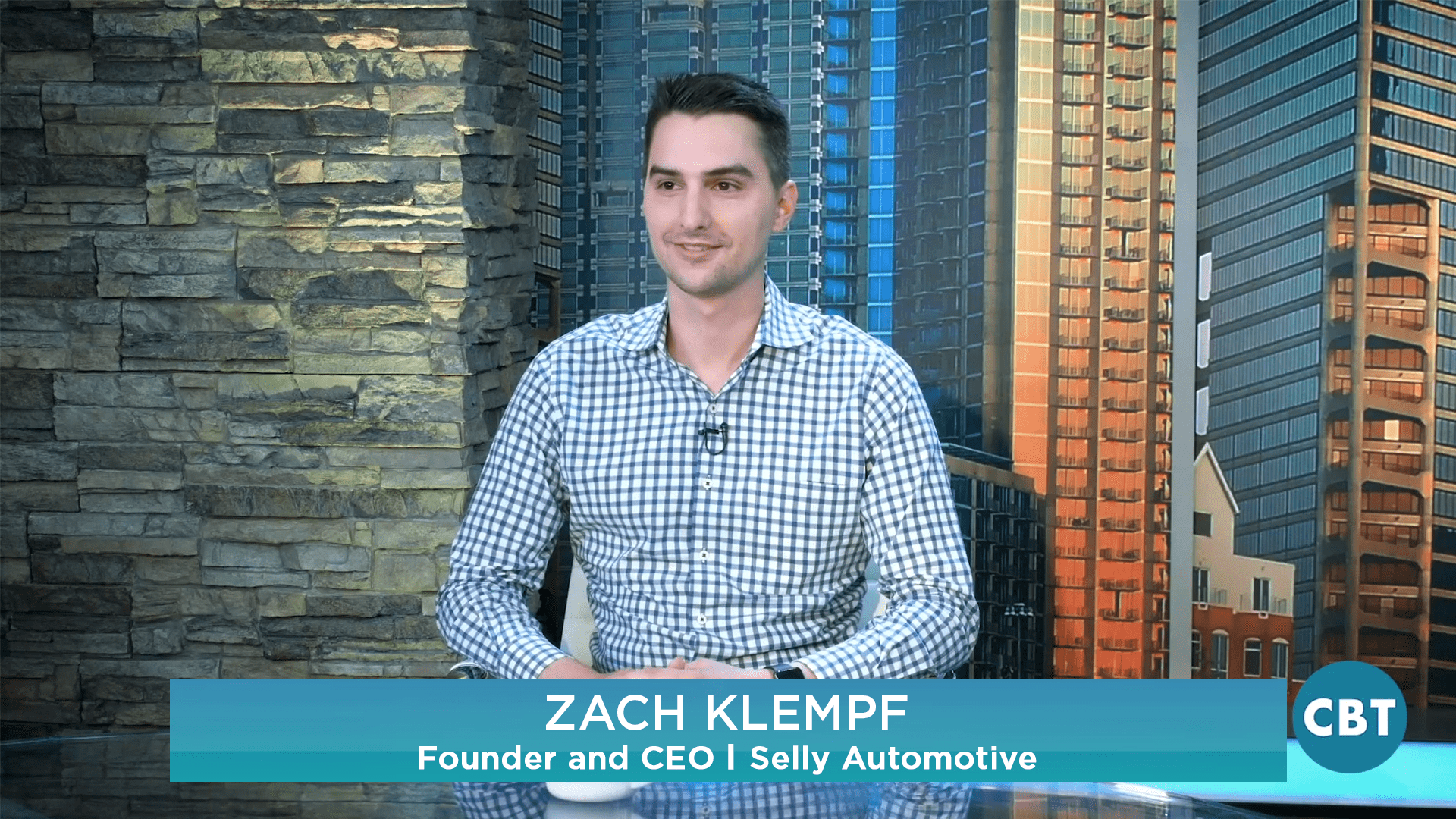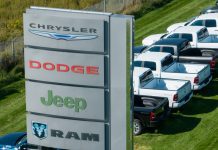Thank you so much for joining us on another edition of CBT News. Today, we’re pleased to welcome back Zach Klempf, founder and CEO of Selly Automotive, to discuss the latest trends and disruptors in the auto retail industry.
Jim Fitzpatrick: I know that you know this young man right here sitting next to me, because he’s been on CBT News a number of times, although it’s been a while, Zach, so welcome back.
Zach Klempf: So excited to be here, Jim.
Jim Fitzpatrick: Yeah. Good, good. You’re crisscrossing the globe now, right? With your company.
Zach Klempf: That’s right. We recently opened an office in Manila, and I’m doing conferences as well across the US. So a lot of sky miles.
Jim Fitzpatrick: I bet. I bet. So you also have your hand on kind of the pulse of the retail automotive industry. Let’s talk a little bit about some of the disrupters that are out there today, that we see. Carvana is getting a lot of play, getting a lot of press.
Jim Fitzpatrick: There’s people that love them and say, “That’s going to be the future of the auto industry. We need as many dealers to jump on board.”
Jim Fitzpatrick: And then there’s others that say, “Well, they’re losing money, and give them another three years, there’ll be done.” What’s your take on that?
Zach Klempf: Well, whenever I go to a dealer conference, dealers are always asking me about Carvana. “How are they still in business, and they’re not profitable.” So Carvana, they went public in 2017, and they’ve never turned a profit. And last quarter, Q2, they had a $64 million loss. But what a lot of dealers don’t realize is fundamentally, they’re being judged just like a tech company, a high growth tech company.
Zach Klempf: So the profitability isn’t important when you’re growing over a hundred percent year over year. And when you look at Carvana’s market cap, they have a $12 billion market cap, which is basically more than Asbury, Penske, and Lithia combined.
Jim Fitzpatrick: Wow.
Zach Klempf: And then CarMax, they have a $14 billion market cap. So they’re catching up to the largest used car dealer, which is CarMax.
Jim Fitzpatrick: That’s right. That’s right. And haven’t been in business really all that long, really when you think about it. Right?
Zach Klempf: That’s right. And there are also other players coming up like Shift for instance, and Vroom. When you look at Shift, Carvana, and Vroom collectively, they raised over 1.6 billion dollars in venture capital. And those two companies will eventually have IPO’s. And there’s going to be even more competition for publicly traded, used car dealers if you will.
Zach Klempf: And then you have companies like Penske, they have their own used car stores as well. So their value prop is going to be less differentiated. They’re kind of a first mover advantage, first to go public, first to really scale online car buying, but they’re going to have a lot of close followers.
Jim Fitzpatrick: Yeah, that’s for sure. And what can be learned? If I’m a new car dealer, from your perspective, what can I learn from a Carvana?
Zach Klempf: So what I would suggest is a new car dealer should go to their website and kind of mystery shop Carvana. One thing they do a great job with is their vehicle display pages. So if you look at that really professional photos they have, you can do a 360 view of the exterior, or interior. It will show you, it doesn’t have satellite radio, you need to add that. And it gives consumers enough comfort where they’re willing to buy these vehicles sight unseen, directly online. So dealers could definitely take notes from the VDP.
Zach Klempf: And another thing Carvana has done really well is brand awareness. They have their vending machines popping up in all sorts of different markets, and it gets consumers’ attention. And they have super bowl commercials. And they’re doing a great job building their marketing awareness with customers.
Jim Fitzpatrick: That’s right. That’s right. And it’s interesting. I haven’t seen one ad yet. They sell used cars. I haven’t seen one ad yet with a price in it, or a payment.
Zach Klempf: That’s right.
Jim Fitzpatrick: And when you think about a traditional car dealers, when they put themselves out there, 10% of the ad, or I should say 10 seconds of the 30 second ad is about themselves, their family, their brand. How long they’ve been around in the marketplace. And the rest is all product and price, product and price. And so I think that’s a huge takeaway that dealers can learn from Carvana, right? That’s to your point, build the brand. Just let the consumer know this is the place to come for a great pre-owned vehicle with a phenomenal warranty, and an easy way to buy.
Jim Fitzpatrick: They’re really selling the customer an easier sales process than to go inside to your dealer.
Zach Klempf: Exactly. We were doing some mystery shopping of Carvana compared to some of our dealers, and they don’t necessarily have the best pricing. But what they’re offering to your point is the convenience of purchasing a car online, and the flexibility of that seven day return policy.
Jim Fitzpatrick: That’s right. That’s right. And customers have, if we learned anything from CarMax, and that was that people are willing to pay the price on the sticker, even though it might not be the lowest price in the marketplace for that vehicle. And there might be… The CarMax might be surrounded with 10 other dealerships around it, that’s selling the same use vehicle for less money. But it wasn’t about that. What was it?
Jim Fitzpatrick: It was about the sales process. And it being a very easy one for consumers to deal with. Right?
Zach Klempf: Exactly. People like the Amazon, or the Apple kind of omnichannel experience. And with Carvana, they’re competitive against dealerships, but dealerships could also be competitive through their own e-commerce like tools. There are a lot of digital retail products that new car dealers could add to their websites, give that experience of that online checkout. And also have the advantage when the consumer comes into the dealership and they see, “Hey, I wanted that BMW 430i, but I see that M-Sport package.”
Jim Fitzpatrick: That’s right.
Zach Klempf: “I want to consider that and [crosstalk 00:05:30] flip on a new vehicle.”
Jim Fitzpatrick: And so many times we see that as consumers that will come in, and they’re dead set on this one particular car, and probably 80% of the time they end up landing on a different car. Right?
Zach Klempf: Exactly.
Jim Fitzpatrick: That’s very common.
Zach Klempf: Oftentimes, a car online will look a little different than when you see it in person.
Jim Fitzpatrick: Yeah, it’s a good point.
Zach Klempf: And touch it, feel it and drive it.
Jim Fitzpatrick: That’s right. A question came up the other day online in kind of this discussion that was being had. And it was that, how do you overcome somebody, or how do you overcome an objection, or how do you overcome when a customer says, “I don’t want to take the car for a ride. I’ve driven it at another dealership, so let’s get right to it.”
Jim Fitzpatrick: And I responded by saying, just embrace it, and say, “Great, that’s not something that you wanted to get done today. You wanted to get done with the numbers and what have you. Let’s cut right to the chase.”
Jim Fitzpatrick: Rather than causing that battle early on to go, “No, you’ve got to drive the car. If you haven’t driven it, how can you buy it?” The old adage of, “Would you buy a shoe if you didn’t try it on?” And all those little phrases that you can go to. But at the end of the day, here you’ve got Carvana, that you don’t take any test drives in the vehicle. The test drive is after you purchase the vehicle. Right?
Zach Klempf: Exactly.
Jim Fitzpatrick: Yeah.
Zach Klempf: And you know, I think the takeaway from that standpoint for the dealers, is the fact that consumers nowadays, they want efficient transaction. They’re visiting less stores. So they don’t want to put up with this much back and forth. They want to see their price.
Jim Fitzpatrick: That’s right.
Zach Klempf: And some consumers, they don’t want the awkwardness of the negotiation process.
Jim Fitzpatrick: That’s right.
Zach Klempf: Or whatever fits for their needs.
Jim Fitzpatrick: Yeah, for sure. For sure. So let’s talk about some of the other disruptors that are out there. You have subscription models, and shared mobility and all of that that’s taking place it right. It makes some dealers nervous, and then other dealers say, “Ah, it’s a fad. It’s nothing to really worry about. We’ve had other things like this come along the pike and they’re down the road.”
Zach Klempf: Yeah, so Cadillac, they shut down their book service, but Porsche, they’re actually expanding their subscription service. And Cox Automotive actually acquired a company called Clutch, which gives a dealership the ability to manage their own subscription service with their platform.
Zach Klempf: So it’s actually something that a dealership can leverage a subscription model, with their pre-owned inventory, give the option of flipping. And then the OEM’s like Porsche, they’re going to have their own subscription services. And you also have Fair, it’s raised over a billion dollars in equity and debt. And they’re selling used cars on a subscription basis, but they’re actually partnering with dealerships. So it’s not a competitive threat.
Jim Fitzpatrick: Yeah. Yeah. And then of course, machine learning, and AI. That seems to be-
Zach Klempf: Huge buzzword.
Jim Fitzpatrick: … all the buzz. All the buzz.
Zach Klempf: And especially in the software world. And unfortunately today, AI can not replace your salesperson. It’s still-
Jim Fitzpatrick: Damn it.
Zach Klempf: … it’s still in the infancy. There’s a lot of blue sky with AI technology. Google’s been at the forefront of that, and they’re able to have an AI system that could actually schedule an appointment, for instance, for a hair salon. So they’re making strides in the right direction, but it’s not going to be able to replace the salesperson.
Jim Fitzpatrick: Yeah, that’s right. That’s right. Thank God for that, right?
Zach Klempf: Right.
Jim Fitzpatrick: It’s the sales department, and the sales people in this industry that build all those beautiful dealerships, isn’t it?
Zach Klempf: Absolutely.
Jim Fitzpatrick: That’s what it’s all about.
Zach Klempf: With machine learning, a lot of companies are leveraging that, for instance, with pricing of inventory, inventory management. So that’s a lot more mature than artificial intelligence at this point.
Jim Fitzpatrick: Yeah. That for sure. Yep. So Gen Z has influencers and brand ambassadors. Talk to us about that.
Zach Klempf: Yeah. So Gen Z’s pretty interesting. They’ve experienced the millennials going through student debt, the great recession. And they actually want to purchase cars. And they want to support companies that have a social mission, which is different than previous generations. And they’re also very tech-enabled. They’ve been using Snapchat, Instagram, the whole idea of “the influencer” was born out of this Gen Z.
Zach Klempf: So from the dealership standpoint, I would say Gen Z is perfect for testimonials, supporting your brand. Like if you asked a baby boomer to give you a video testimonial, it might be a little hard, but a Gen Zer could get their iPhone out and do it right on the lot as soon, as they purchase the vehicle.
Jim Fitzpatrick: Yeah, they grew up that way, right?
Zach Klempf: And if they have a great experience, they’re going to let everyone know. And on the other side, if they have a bad experience, they’re going to Yelp, giving you one star, Google reviews, Dealer Rater, all of those websites. So you got to be careful.
Jim Fitzpatrick: That’s right take care of your Generation Z-
Zach Klempf: Exactly.
Jim Fitzpatrick: … people. Right?
Zach Klempf: Right.
Jim Fitzpatrick: Yeah. And, yeah, that’s incredible that… Because these kids really, I say kids, but these kids really grew up with iPhones in their face 24/7, right?
Zach Klempf: Exactly.
Jim Fitzpatrick: They know more about taking a good video than videographers do.
Zach Klempf: Kids get iPhones in elementary school nowadays.
Jim Fitzpatrick: Yeah. That’s right.
Zach Klempf: So they’re tech-enabled from the start.
Jim Fitzpatrick: Isn’t that incredible? Yeah.
Zach Klempf: I wish I had one in elementary school.
Jim Fitzpatrick: Yeah. So what’s next for your company? What’s around the corner for Selly?
Zach Klempf: Yeah, so we’ve actually been working on an integration with Frazer DMS. They have 21,000 dealerships, so it’s going to be a big opportunity for us. And we’re going to be the first fully integrated CRM with Frazer.
Jim Fitzpatrick: Wow.
Zach Klempf: So that’s a big opportunity right there.
Jim Fitzpatrick: Yeah, for sure.
Zach Klempf: Our developers have been hard at work on a lot of great updates for the company, and we have some other DMS partners coming down the pipeline as well.
Jim Fitzpatrick: Very nice. Wow, that’s great. How long has Selly been around now?
Zach Klempf: So a little over four and a half years.
Jim Fitzpatrick: Okay.
Zach Klempf: And I started it when I was 23 and a half, and now I’m 28 and-
Jim Fitzpatrick: There you go. 23 and a half [crosstalk 00:11:13]. You know you’re still young when you’re out in those half years. Right? Like my grandson said he’s three and a half, so I’m going to tell him I met somebody that was 23 and a half. And started… That’s great. Well, Zach Klempf, thank you so much for joining us on CBT news. It’s always a pleasure having you in the studio, and kind of give us an update from your perspective as to how you see the auto industry.
Zach Klempf: Thanks Jim.
Jim Fitzpatrick: Thank you.
CBT Automotive Network. The number one most-watched network in retail automotive. This has been a JBF Business Media Production.









